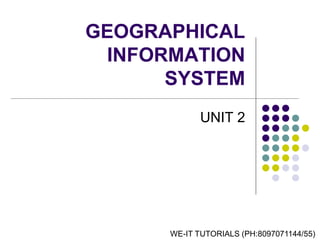
Geographical information system unit 2
- 1. GEOGRAPHICAL INFORMATION SYSTEM UNIT 2 WE-IT TUTORIALS (PH:8097071144/55)
- 2. use existing GIS data GIS data for a project is often a matter of knowledge, experience, and luck. framework data, which typically include seven basic layers 1. geodetic control (accurate positional framework for surveying and mapping) 2. orthoimagery (rectified imagery such as orthophotos) 3. Elevation 4. Transportation 5. Hydrography 6. governmental units 7. cadastral information WE-IT TUTORIALS (PH:8097071144/55)
- 3. What is metadata Metadata provide information about geospatial data Metadata are important to anyone who plans to use public data for a GIS project metadata let us know if the data meet our specific needs for area coverage, data quality, and data currency. metadata show us how to transfer, process, and interpret geospatial data. metadata include the contact for additional information WE-IT TUTORIALS (PH:8097071144/55)
- 4. FGDC metadata standards categories: Identification information Data quality information Spatial data organization information Spatial reference information Entity and attribute information Distribution information Metadata reference information WE-IT TUTORIALS (PH:8097071144/55)
- 5. how existing data is converted in GIS Public data are delivered in a variety of formats. Unless the data format is compatible with the GIS package in use. we must first convert the data. Direct Translation Direct translation uses a translator in a GIS package to directly convert geospatial data from one formal to another Neutral Format : The Spatial Data Transfer Standard (SDTS) is a neutral format approved by the Federal Information Processing Standards (FIPS) Program in 1992 WE-IT TUTORIALS (PH:8097071144/55)
- 6. SDTS uses "profiles" to transfer spatial data Each profile is targeted at a particular type of spatial data. Currently there are five SDTS profiles: The Topological Vector Profile (TVP) covers DLG, TIGER, and other topology-based vector data. The Raster Profile and Extensions (RPE) accommodate DOQ, DEM, and other raster data. The Transportation Network Profile (TNP) covers vector data with network topology. The Point Profile supports geodetic control point data. The Computer Aided Design and Drafting Profile (CADD) supports vector-based CADD data, with or without topology. WE-IT TUTORIALS (PH:8097071144/55)
- 7. various methods of creating new GIS Data Creating New Data Address geocoding, also called address matching, can create point features from street addresses. Street addresses are therefore an important data source for creating new data. Remotely Sensed Data : Satellite images can be digitally processed to produce a wide variety of thematic data for a GIS project. Field Data : field survey typically provides data for determining parcel boundaries Text Files with x-,y-Coordinates : Geospatial data can be generated from a text file that contains x-, y- coordinates Cont……….. WE-IT TUTORIALS (PH:8097071144/55)
- 8. Digitizing Using a Digitizing Table Digitizing is the process of converting data from analog to digital format. Scanning A scanner converts an analog map into a scanned image file in raster format. WE-IT TUTORIALS (PH:8097071144/55)
- 9. What is geometric transformation Geometric transformation is the process of using a set of control points and transformation equations to register a digitized map, a satellite image, or an aerial photograph onto a projected coordinate system. WE-IT TUTORIALS (PH:8097071144/55)
- 10. Map-to-Map and Image-to-Map transformations Geometric transformation converts the newly digitized map into projected coordinates in a process often called map-to-map transformation. Image-to-map transformation applies to remotely sensed data “satellite image into projected coordinates” WE-IT TUTORIALS (PH:8097071144/55)
- 11. transformation methods proposed for transformation from one coordinate system to another. WE-IT TUTORIALS (PH:8097071144/55)
- 12. Affine Transformation The affine transformation allows rotation, translation, skew, and differential scaling on a rectangular object, while preserving line parallelism WE-IT TUTORIALS (PH:8097071144/55)
- 13. A geometric transformation typically involves three steps. Step 1 updates the control points to real-world coordinates. Step 2 uses the control points to run an affine transformation. Step 3 creates the output by applying the transformation equations to the input features. WE-IT TUTORIALS (PH:8097071144/55)
- 14. Root Mean Square (RMS) Error acceptable value ranges(rms) WE-IT TUTORIALS (PH:8097071144/55)
- 15. Resampling of Pixel Values WE-IT TUTORIALS (PH:8097071144/55)
- 16. END OF UNIT 2 WE-IT TUTORIALS (PH:8097071144/55)
Editor's Notes
- Identification information basic information about the data set, including title, geographic data covered, and currency. Data quality information information about the quality of the data set, including positional and attribute accuracy, completeness, consistency, sources of information, and methods used to produce the data. Spatial data organization information information about the data representation in the data set, such as method for data representation (e.g., raster or vector) and number of spatial objects. Spatial reference information description of the reference frame for and means of encoding coordinates in the data set, such as the parameters for map projections or coordinate systems, horizontal and vertical datums, and the coordinate system resolution. Entity and attribute information information about the content of the data set, such as the entity types and their attributes and the domains from which attribute values may be assigned. Distribution information information about obtaining the data set. Metadata reference information information on the currency of the metadata information and the responsible party.
